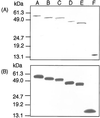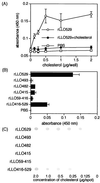Dissociated linkage of cytokine-inducing activity and cytotoxicity to different domains of listeriolysin O from Listeria monocytogenes
- PMID: 11854218
- PMCID: PMC127785
- DOI: 10.1128/IAI.70.3.1334-1341.2002
Dissociated linkage of cytokine-inducing activity and cytotoxicity to different domains of listeriolysin O from Listeria monocytogenes
Abstract
Listeriolysin O (LLO), a cholesterol-binding cytolysin of Listeria monocytogenes, exhibits cytokine-inducing and cytolytic activities. Because the cytolytic activity was abolished by cholesterol treatment but the cytokine-inducing activity was not, these activities appeared to be linked to different domains of the LLO molecule. In this study, we constructed recombinant full-length LLO (rLLO529) and various truncated derivatives and examined their cytolytic, cholesterol-binding, and gamma interferon (IFN-gamma)-inducing activities. rLLO529 exhibited both IFN-gamma-inducing and cytolytic activities. Four truncated rLLOs possessing different C termini, which did not exert either cytolytic or cholesterol-binding activity, stimulated IFN-gamma production in normal spleen cells. However, a truncated rLLO corresponding to domain 4 (rLLO416-529) did not exhibit IFN-gamma-inducing activity, whereas it did bind to immobilized cholesterol. In addition, though the hemolysis induced by rLLO529 was inhibited by rLLO416-529, such inhibition was not detected upon rLLO529-induced IFN-gamma production. These data indicated that domain 4 was responsible for binding of LLO to membrane cholesterol followed by oligomerization and pore formation by the entire LLO molecule. In contrast, the other part of LLO, corresponding to domain 1-3, was essential for IFN-gamma-inducing activity. These findings implied a novel aspect of the function of LLO as a bacterial modulin.
Figures









Similar articles
-
Seeligeriolysin O, a cholesterol-dependent cytolysin of Listeria seeligeri, induces gamma interferon from spleen cells of mice.Infect Immun. 2003 Jan;71(1):234-41. doi: 10.1128/IAI.71.1.234-241.2003. Infect Immun. 2003. PMID: 12496171 Free PMC article.
-
Essential role of interleukin-12 (IL-12) and IL-18 for gamma interferon production induced by listeriolysin O in mouse spleen cells.Infect Immun. 2002 Mar;70(3):1049-55. doi: 10.1128/IAI.70.3.1049-1055.2002. Infect Immun. 2002. PMID: 11854182 Free PMC article.
-
Cytolysin-dependent escape of the bacterium from the phagosome is required but not sufficient for induction of the Th1 immune response against Listeria monocytogenes infection: distinct role of Listeriolysin O determined by cytolysin gene replacement.Infect Immun. 2007 Aug;75(8):3791-801. doi: 10.1128/IAI.01779-06. Epub 2007 May 21. Infect Immun. 2007. PMID: 17517863 Free PMC article.
-
Listeriolysin O: A phagosome-specific cytolysin revisited.Cell Microbiol. 2019 Mar;21(3):e12988. doi: 10.1111/cmi.12988. Epub 2019 Jan 15. Cell Microbiol. 2019. PMID: 30511471 Free PMC article. Review.
-
Biological effects of listeriolysin O: implications for vaccination.Biomed Res Int. 2015;2015:360741. doi: 10.1155/2015/360741. Epub 2015 Mar 22. Biomed Res Int. 2015. PMID: 25874208 Free PMC article. Review.
Cited by
-
Nisin inducible production of listeriolysin O in Lactococcus lactis NZ9000.Microb Cell Fact. 2008 Jul 29;7:24. doi: 10.1186/1475-2859-7-24. Microb Cell Fact. 2008. PMID: 18664263 Free PMC article.
-
Listeriolysin O as a strong immunogenic molecule for the development of new anti-tumor vaccines.Hum Vaccin Immunother. 2013 May;9(5):1058-68. doi: 10.4161/hv.23871. Epub 2013 Feb 11. Hum Vaccin Immunother. 2013. PMID: 23399758 Free PMC article. Review.
-
A listeriolysin O subunit vaccine is protective against Listeria monocytogenes.Vaccine. 2020 Aug 10;38(36):5803-5813. doi: 10.1016/j.vaccine.2020.06.049. Epub 2020 Jul 17. Vaccine. 2020. PMID: 32684498 Free PMC article.
-
Listeriolysin O-induced membrane permeation mediates persistent interleukin-6 production in Caco-2 cells during Listeria monocytogenes infection in vitro.Infect Immun. 2005 Jul;73(7):3869-77. doi: 10.1128/IAI.73.7.3869-3877.2005. Infect Immun. 2005. PMID: 15972472 Free PMC article.
-
Cancer immunotherapy targeting the high molecular weight melanoma-associated antigen protein results in a broad antitumor response and reduction of pericytes in the tumor vasculature.Cancer Res. 2008 Oct 1;68(19):8066-75. doi: 10.1158/0008-5472.CAN-08-0287. Cancer Res. 2008. PMID: 18829565 Free PMC article.
References
-
- Alouf, J. E. 1999. Introduction to the family of the structurally related cholesterol-binding cytolysins (‘sulfhydryl-activated' toxins), p. 443-456. In J. E. Alouf and J. H. Freer (ed.), The comprehensive sourcebook of bacterial protein toxin, 2nd ed. Academic Press, London, United Kingdom.
-
- Aniagolu, J., G. M. Swartz, Jr., J. Dijkstra, J. W. Madsen, J. J. Raney, and S. J. Green. 1995. Analysis of anticholesterol antibodies using hydrophobic membranes. J. Immunol. Methods 182:85-92. - PubMed
-
- Baba, H., I. Kawamura, C. Kohda, T. Nomura, Y. Ito, T. Kimoto, I. Watanabe, S. Ichiyama, and M. Mitsuyama. 2001. Essential role of domain 4 of pneumolysin from Streptococcus pneumoniae in cytolytic activity as determined by truncated proteins. Biochem. Biophys. Res. Commun. 281:37-44. - PubMed
-
- Billington, S. J., B. H. Jost, and J. G. Songer. 2000. Thiol-activated cytolysins: structure, function and role in pathogenesis. FEMS Microbiol. Lett. 182:197-205. - PubMed
Publication types
MeSH terms
Substances
LinkOut - more resources
Full Text Sources
Other Literature Sources

